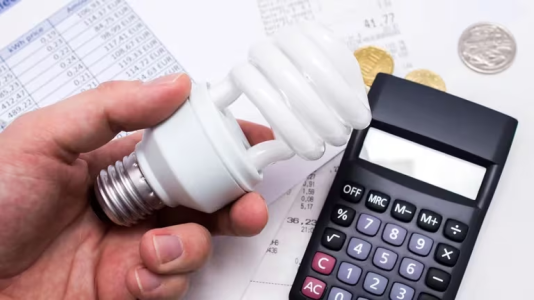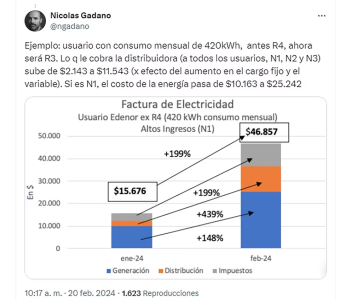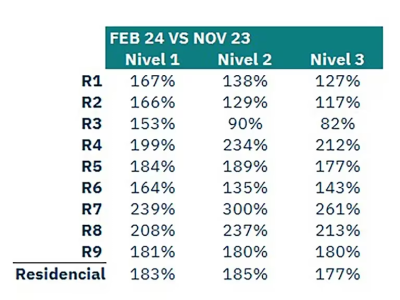MarksElian
New member
Electricity increases: why some users will have increases much higher than those anticipated by the - Infobae

Source:

 www.infobae.com
www.infobae.com
February 20, 2024
The bills that will arrive in March will show the effect of the increase in the cost of generation, distribution and the new consumption categories. From April, progress will be made in a more restrictive subsidy scheme that will imply more increases
By Agustín Maza

In March the new electricity rates will arrive with the increases corresponding to February.
After the publication of the new electricity rate tables for users of the Buenos Aires Metropolitan Area (AMBA) , under the concession of Edenor and Edesur , specialists affirm that the increases in electricity bills will be higher than those reported by the Government . That is the result not only of the increase in the distribution segment but also of the cost of generation and the charging formula that has been in effect since last Friday.
The National Electricity Regulatory Entity (Enre) modified the differentiation of residential users by consumption, which until now had nine categories and went to four. The R1 are those that consume up to 150 kwh per month, the R2 between 151 and 400 kwh, the R3 between 401 and 600 kwh, while the R4 will group consumption greater than 600 kwh. This last group was previously divided into R7 (601 and 700 kwh); R8 (701 and 1400 kwh), and R9 more than (1400 kwh).
Although 70% of users are concentrated in R1 and R2, R4 users will pay a sharp increase in the fixed distribution cost, of 419%, once they exceed the stipulated consumption threshold and without differentiating between the payment capacity of said users. The latter happens because the rate is not segmented with subsidies in distribution, but is done in generation from 3 universes: high income (N1), low income (N2) and medium income (N3) determined by the Basket Total Basic (CBT) from Indec .
In this regard, through his account on the social network between 600 and 700 kWh) is now R4, and only for a fixed charge you will have to pay from $5,789 to $30,054 per month, regardless of whether you have a high, medium or low income.”

Rate increase for an Income Level 1 R3 user.
The specialist explained that a user with monthly consumption of 420 kwh, which will now be R3, will pay for the distribution cost of $2,143 to $11,543 for the concept of fixed and variable charge. If it is N1, the cost of energy went from $10,163 to $25,242. From the simulation it appears that this household will go from paying $15,676 in January to $46,857, that is, an almost 200% increase in the final bill.
“Users with the same consumption but low income (N2) face the same increase in distribution costs (from $2,143 to $11,543), without increases in the cost of energy. This asymmetry means that the distributor takes 86% of the bill before taxes, and CAMMESA only 14%,” added Gadano. In that case the ticket will go from $5,133 to $17,117, which represents a jump of 233 percent.
The Ministry of Energy had reported on Thursday that starting this month there will be an increase of up to 150% in the electricity rates paid by high-income users, in the bills that will be paid in March. Low-income consumers, they said, (categorized as N2) will see an increase of around 70% and middle-income consumers (known as N3) around 65%, although for the latter universe it does exceed 600 KW/h. jump was going to be in the area of 130 percent.
A report from the consulting firm Economía y Energía showed that the increases for high-income R1s will be 167%, while those with low incomes will be 138% and 127% for the middle segment. These increases are above those officially reported.

Light increases with current consumption categories. (Economy and Energy)
In the case of the R2, which can function as the average consumption of a typical family, the average annual bill of the N1, that is, discounting seasonality, would go from $8,188 to $21,759 (166%) as of February. For the N2 the ticket would go from $8,188 to $21,759 (129%) and the N3 from $2,765 to $6,007 (117%) in that period.
With an eye on April-May, it is planned to introduce a new scheme that will replace the current segmentation , focusing subsidies on those households whose energy expenditure exceeds 10% of their income. In this way, state support would focus on the amount that exceeds said percentage and will take into account the particularities of each bioclimatic zone.
In any case, the allocation will be more restrictive than the current one, seeking to adjust subsidies by 0.5 points of GDP this year. Subsidized consumption will not be up to 400 kwh as until now, while those who have a car or motorcycle less than five years old . Previously that threshold was three years.

Source:

Aumentos de luz: por qué algunos usuarios tendrán subas muy superiores a las anticipadas por el Gobierno
Las boletas que llegarán en marzo mostrarán el efecto del aumento en el costo de generación, de distribución y las nuevas categorías de consumo. Desde abril se avanzará en un esquema de subsidios más restrictivo que implicará más incrementos
February 20, 2024
The bills that will arrive in March will show the effect of the increase in the cost of generation, distribution and the new consumption categories. From April, progress will be made in a more restrictive subsidy scheme that will imply more increases
By Agustín Maza

In March the new electricity rates will arrive with the increases corresponding to February.
After the publication of the new electricity rate tables for users of the Buenos Aires Metropolitan Area (AMBA) , under the concession of Edenor and Edesur , specialists affirm that the increases in electricity bills will be higher than those reported by the Government . That is the result not only of the increase in the distribution segment but also of the cost of generation and the charging formula that has been in effect since last Friday.
The National Electricity Regulatory Entity (Enre) modified the differentiation of residential users by consumption, which until now had nine categories and went to four. The R1 are those that consume up to 150 kwh per month, the R2 between 151 and 400 kwh, the R3 between 401 and 600 kwh, while the R4 will group consumption greater than 600 kwh. This last group was previously divided into R7 (601 and 700 kwh); R8 (701 and 1400 kwh), and R9 more than (1400 kwh).
Although 70% of users are concentrated in R1 and R2, R4 users will pay a sharp increase in the fixed distribution cost, of 419%, once they exceed the stipulated consumption threshold and without differentiating between the payment capacity of said users. The latter happens because the rate is not segmented with subsidies in distribution, but is done in generation from 3 universes: high income (N1), low income (N2) and medium income (N3) determined by the Basket Total Basic (CBT) from Indec .
In this regard, through his account on the social network between 600 and 700 kWh) is now R4, and only for a fixed charge you will have to pay from $5,789 to $30,054 per month, regardless of whether you have a high, medium or low income.”

Rate increase for an Income Level 1 R3 user.
The specialist explained that a user with monthly consumption of 420 kwh, which will now be R3, will pay for the distribution cost of $2,143 to $11,543 for the concept of fixed and variable charge. If it is N1, the cost of energy went from $10,163 to $25,242. From the simulation it appears that this household will go from paying $15,676 in January to $46,857, that is, an almost 200% increase in the final bill.
“Users with the same consumption but low income (N2) face the same increase in distribution costs (from $2,143 to $11,543), without increases in the cost of energy. This asymmetry means that the distributor takes 86% of the bill before taxes, and CAMMESA only 14%,” added Gadano. In that case the ticket will go from $5,133 to $17,117, which represents a jump of 233 percent.
The Ministry of Energy had reported on Thursday that starting this month there will be an increase of up to 150% in the electricity rates paid by high-income users, in the bills that will be paid in March. Low-income consumers, they said, (categorized as N2) will see an increase of around 70% and middle-income consumers (known as N3) around 65%, although for the latter universe it does exceed 600 KW/h. jump was going to be in the area of 130 percent.
A report from the consulting firm Economía y Energía showed that the increases for high-income R1s will be 167%, while those with low incomes will be 138% and 127% for the middle segment. These increases are above those officially reported.

Light increases with current consumption categories. (Economy and Energy)
In the case of the R2, which can function as the average consumption of a typical family, the average annual bill of the N1, that is, discounting seasonality, would go from $8,188 to $21,759 (166%) as of February. For the N2 the ticket would go from $8,188 to $21,759 (129%) and the N3 from $2,765 to $6,007 (117%) in that period.
With an eye on April-May, it is planned to introduce a new scheme that will replace the current segmentation , focusing subsidies on those households whose energy expenditure exceeds 10% of their income. In this way, state support would focus on the amount that exceeds said percentage and will take into account the particularities of each bioclimatic zone.
In any case, the allocation will be more restrictive than the current one, seeking to adjust subsidies by 0.5 points of GDP this year. Subsidized consumption will not be up to 400 kwh as until now, while those who have a car or motorcycle less than five years old . Previously that threshold was three years.

